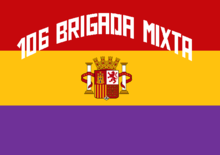| "Si me quieres escribir" | |
|---|---|
 Flag of a mixed brigade of the Spanish Republic Flag of a mixed brigade of the Spanish Republic | |
| Song | |
| Language | Spanish |
| English title | "Battle at Gandesa" |
"Si me quieres escribir" (English: "If You Want to Write to Me"), also known as "Ya sabes mi paradero" ("You Know Where I Am Posted") and "El frente de Gandesa" (The Gandesa Front), is one of the most famous songs of the Spanish Republican troops during the Spanish Civil War. According to Emilia Salas Viú, widow of Rodolfo Halffter, the author of the lyrics was Emilio Prados.
Background
The melody is based on a former song of the Spanish military units in the Rif Wars in Northern Morocco in the 1920s. The lyrics may change according to the location of the combat and the units involved. The Gandesa front and the blowing up of pontoons and bridges are related to the passage of the river in the Battle of the Ebro, also mentioned in ¡Ay Carmela!. The Spanish Republican combat engineers were capable of repeatedly repairing the bridges and pontoons in order to allow the loyalist troops to cross the river —at least a few hours every day— despite the steady bombings of the Nazi Condor Legion and the Italian Aviazione Legionaria, as well as the intentional flooding by releasing water from dams upstream.
The moros (Moors) mentioned in some verses are the Regulares, the feared Moroccan shock troop units of the Nationalist faction that kept pounding Republican positions for months at the Gandesa frontline.
Lyrics
- The main stanza begins mostly with Si me quieres escribir; it is usually repeated at the end. Also every pair of verses is repeated twice. There are many different stanzas and these may be subject to local variations and be sung in different combinations. The following are some of the most common:
|
|
Variants
One popular Civil War variant of this song where the lyrics make reference to the Siege of Madrid is known as "Los Emboscados". These are two of the main stanzas:
|
|
The first stanza of "Los emboscados" is an adaptation of an older variant of 1936 that was not related to the war:
|
See also
- Songs of the Spanish Civil War
- Canciones de la Guerra Civil Española
- The Ballad of the Fallen
- To All We Stretch the Open Arm
References
- Canciones republicanas
- Chica, Francisco (2011). Arcadia en llamas: República y guerra civil en Málaga, 1931-1937 [Arcadia in flames: Republic and civil war in Malaga, 1931-1937] (in Spanish). Seville; Málaga: Espuela de Plata; Instituto Municipal del Libro. p. 21.
Prados fue el autor de las letras de estas conocidísimas piezas: 'El Quinto Regimiento', 'El tren Blindado', 'Fuerte de San Cristóbal' y 'Si me quieres escribir'
In a footnote, the author explains that: "Así me lo confirmó alguien que conocía bien el tema, Emilia Salas Viú, viuda de Rodolfo Halffter, en la entrevista que mantuve con ella en México D. F. en octubre de 1991" . - Beevor, Antony. (2006). The Battle for Spain. The Spanish Civil War, 1936–1939. Penguin Books. London. pp. 352–353
- Beevor, Antony. (2006). The Battle for Spain. The Spanish Civil War, 1936–1939. Penguin Books. London. p. 352.
- ^ "Si me quieres escribir - Ya sabes mi paradero - El Frente de Gandesa - Los emboscados". Archived from the original on 2017-12-07. Retrieved 2015-02-23.
- Si Me Quieres Escribir - YouTube
External links
- Si Me Quieres Escribir - Quetzal
- Si me quieres escribir - Tercera Brigada Mixta
- Letra si me quieres escribir - Skalariak
- Si me quieres escribir live - Marina Rosell